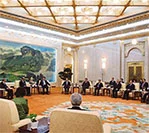THE launch of the Asian Infrastructure Investment Bank (AIIB), which is led by China that holds a 50 per cent stake in it, is perhaps one of the biggest news items of this year, and promises to be a major game-changer in the years to come.
Though dominated by China, from the outset it was clear that the AIIB sought to have as many partners in it so as to lend the impression that it was more than simply a Chinese bank out to bankroll major infrastructural projects across the Asian continent.
And the fact that more than 20 Asian countries were present during its official launch last week would suggest that it has started on the right footing, presenting itself as a potential challenger to both the World Bank (WB) and the Asian Development Bank (ADB).
That China has seen fit to set up the AIIB and has made vigorous attempts to court other Asian countries into its fold tells us some things about the state of international politics in the Asian domain at the moment.
For starters it suggests that China sees its role as changing in the Asian domain, and that it is taking proactive steps towards addressing its formerly isolationist posture in the recent past. By funding infrastructure projects in partner-countries, China is sending out the message that its growing role in the Asian region will be enhanced via soft, rather than hard, power.
China’s economic development, which has been spectacular by all accounts, is propelling both the country and its people to look ever outwards for greener pastures, and to locate their long-term economic health and human security in the broader Asian zone.
Over the past decade, we have witnessed the emergence of a relatively new phenomenon that was not seen up to the late 1980s, namely that of Chinese tourists travelling in large numbers outside China, and getting to know the world better — a luxury that they could not afford in the past.
Today however, the sight of large numbers of middle-class tourists from China in places like Europe and Southeast Asia is no longer new, and increasingly we are seeing the rise and spread of the Chinese professional expatriate – a development akin to the rise and spread of Japanese professionals across the world from the 1970s.
This also points to the major social-demographic changes taking place in China today, with the rise of the new middle-class whose consumption power is matched only by their middle-class aspirations, and who see themselves as becoming part of the global middle-class well beyond the borders of a single country.
During my own trips to the China-North Korea border, I have come across brand new cities and commercial complexes where the up-and-coming professional classes of China flock, in environs that resemble downtown New York or London, complete with auto dealers selling the latest models of luxury cars.
These signs and symbols of prosperity and success make up the cultural capital of this new class of Chinese professionals who see the rest of the world as vistas for entrepreneurship and social mobility, and the world beyond China is seen as less hostile or alien to them.
For the rest of Asia the prospect of the AIIB is a positive one as well, for it signals that the WB and ADB are no longer the primary sources of loans for development. Regardless of the criticism levelled against the AIIB by its competitors, the fact remains that vast swathes of Asia – particularly Central and Southeast Asia – are open for investment and development.
In terms of logistics, transport and communication, Central Asia’s proximity to China and the fact that it is home to some of the world’s biggest mineral, rare earths and fuel deposits means that it is bound to be an important region for rapidly-growing countries like China.
China also sees itself playing the role of road-builder and bridge-builder across Asia, as it has been investing heavily in land-based communicative infrastructure that connects it to many parts of mainland Southeast Asia by now.
But perhaps the most important aspect of the AIIB is the fact that by its very existence, it has added yet another alternative source of funding and development aid to other Asian countries, some of which have felt themselves squeezed by the paucity of lending agencies in the past.
Here banking and national agendas come together, as noted by Eric Davis in his study of the rise and fall of the Bank of Egypt (Challenging Colonialism: Bank Misr and Egyptian Industrialisation 19201941).
Davis noted that banks — both national and regional — are key players in not only economic development but also other related nationalist-regional ambitions and long-term plans.
The story of the Egyptian bank’s rise and fall was not merely an account of economic development, but also an account of Egypt’s struggle against colonialism and its attempts to leap towards the age of industrialisation to liberate its economy.
Its demise, argued Davis, contributed in part to Egypt’s failure in the 1950s to move towards heavy industries, which in turn, kept the country in the same cycle of import-substitution.
Should the AIIB project take off successfully, and should it be able to fund the infrastructure projects that are deemed of strategic worth by both China and its partners, the Asian continent may well witness its own second industrial revolution on a scale that is unprecedented.
China of course will seek out partners and projects that will benefit its own socio-economic, material and developmental demands, but in the process, many other Asian countries stand to benefit as well.
Though it is too early to speculate on the successes that it may achieve, this has to be one of the major landmark events of the year, and would be worth watching in the decade to come.
Article by Dr Farish Noor which appeared in New Straits Times, 27 October 2014.





